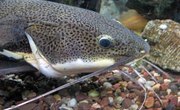
Mud minnows are small fish that inhabit shallow muddy waters and are native to North America. Easy to catch and effective as bait for a variety of fresh and saltwater game fish, mud minnows typically grow to only a few inches in length. Rigging a mud minnow can be done in a variety of ways depending on the situation and type of fishing you will be doing. However, there are basic ways that a mud minnow can be placed on a hook to provide great action for attracting fish.
Items you will need
7 foot medium heavy rod and matched reel
Monofilament fishing line
Size 8 or 10 bait hook
Weight
Pliers
Tie a #8 or #10 bait hook onto the end of your line with a Palomar knot. Feed the line through the eye of the hook so it exits on the point side. Double the line and feed it back through. You will now have a loop on one side of the eye and a double line on the other.
Tie an overhand knot with the loop and doubled line and pull the loop down and around the bend of the hook. Moisten the knot and pull tight. Trim excess with scissors.
Hold a mud minnow in one hand and the hook in the other. Insert the point of the hook through the bottom of the jaw and out just behind the nose. This rig allows for good presentation; however, the minnow cannot typically live long due to inability to take in air through the gills.
Rig the mud minnow through the tail by inserting the point of the hook through the side of the fish just in front of the the tail fin. This rig is typically used without weight to allow the minnow to swim freely and naturally.
Insert the hook through the back of the mud minnow just in front of the dorsal fin. Slide the hook point only through the skin and do not allow it to penetrate deep enough to contact the spine, which can cause injury or death to the minnow before presenting it as bait.
Tips
- Crimp a weight onto the line several inches above the hook if needed.
- A sliding weight such as an egg weight can be used and must be placed on the line before the hook is attached. Typically, a swivel is tied on to the line several inches above the hook as a stop for the weight so it does not slide down and contact the hook.
References
Tips
- Crimp a weight onto the line several inches above the hook if needed.
- A sliding weight such as an egg weight can be used and must be placed on the line before the hook is attached. Typically, a swivel is tied on to the line several inches above the hook as a stop for the weight so it does not slide down and contact the hook.
Writer Bio
Keith Dooley has a degree in outdoor education and sports management. He has worked as an assistant athletic director, head coach and assistant coach in various sports including football, softball and golf. Dooley has worked for various websites in the past, contributing instructional articles on a wide variety of topics.



